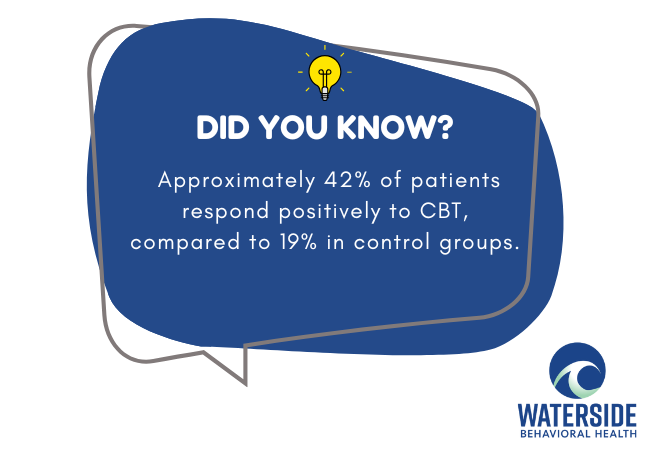Post-Traumatic Stress Disorder (PTSD) leaves more than just emotional scars—it alters the very structure and function of the brain. Those who have experienced trauma often find themselves stuck in a cycle of intrusive memories, hypervigilance, emotional numbness, and unrelenting anxiety. The journey to healing can feel impossible. But modern psychological interventions like Cognitive Behavioral Therapy (CBT) offer hope—hope rooted not in suppressing the past but in changing how the brain responds to it.
At Waterside Behavioral Health, we understand that trauma recovery is not just about coping—it’s about transformation. It’s about rewiring the brain’s trauma responses to restore a sense of safety, self-worth, and emotional control. CBT is one of the most researched and proven methods for treating PTSD and trauma-related disorders, and it continues to show remarkable results in both short- and long-term recovery.
Understanding the Impact of Trauma on the Brain
When an individual undergoes trauma, the brain reacts in ways that are protective in the short term but damaging if those changes persist. The amygdala—our brain’s fear center—becomes overactive, triggering heightened anxiety and fear responses. The prefrontal cortex, which is responsible for rational thought and emotion regulation, becomes less active. Additionally, the hippocampus—essential for memory processing—may shrink in size, making it difficult for trauma survivors to distinguish past from present danger.
These neurobiological changes contribute to the debilitating symptoms of PTSD, such as flashbacks, panic attacks, nightmares, emotional dysregulation, and avoidance behaviors. Without effective intervention, these patterns become deeply ingrained, reinforcing distress and detachment over time.
This is where CBT comes in—not just as a form of talk therapy, but as a mechanism for neurological repair.
How CBT Facilitates Trauma Recovery
CBT is based on the idea that our thoughts, emotions, and behaviors are interconnected. By identifying and restructuring distorted thought patterns, individuals can begin to shift their emotional responses and behaviors in a healthier direction. For trauma survivors, CBT offers practical tools to confront painful memories, reframe negative self-beliefs, and reduce physiological arousal.
One of the key strengths of CBT is its structured, goal-oriented approach. Clients work with a therapist to set clear objectives and measure progress over time. Techniques such as cognitive restructuring, exposure therapy, and behavioral activation are tailored to target trauma-related symptoms in a safe and controlled way.
Cognitive restructuring, for instance, helps individuals identify irrational or self-defeating beliefs rooted in trauma—such as “I’m to blame” or “I’ll never be safe again.” These beliefs are challenged and replaced with more balanced, realistic perspectives. Over time, this mental shift rewires neural circuits and calms hyperarousal.
Exposure therapy, another CBT technique, involves gradually confronting trauma reminders in a safe setting. By repeatedly facing these cues without actual danger present, the brain begins to “unlearn” its association between the trigger and the threat. This desensitization reduces anxiety, flashbacks, and avoidance behaviors.
These interventions, practiced consistently, not only change behavior but physically alter the brain. Research shows that CBT can normalize amygdala activity, increase hippocampal volume, and enhance prefrontal cortex function—key changes that support recovery from PTSD.
Personalized Healing: No Two Trauma Journeys Are the Same
At Waterside Behavioral Health, we believe that trauma therapy should never be one-size-fits-all. CBT provides a versatile foundation that can be personalized to each individual’s needs. Some clients may benefit most from traditional CBT protocols, while others may integrate additional modalities like mindfulness-based techniques or somatic practices.
Trauma manifests differently in each person. Some experience dissociation and numbness; others are plagued by constant fear and irritability. CBT allows for this variability and adapts to the client’s pace and comfort level. For example, someone with childhood trauma may need a longer trust-building phase before engaging in exposure work, whereas another individual might be ready to dive into cognitive restructuring from the start.
CBT also emphasizes self-monitoring and homework assignments, which help clients track their progress and practice coping strategies outside of sessions. This active participation empowers individuals and reinforces the belief that change is not only possible—it’s already happening.
Trauma in Everyday Life: The Lingering Effects
One of the most challenging aspects of PTSD is its tendency to disrupt daily life in unexpected ways. Individuals may find themselves constantly on edge, easily startled by loud noises, or avoiding social interactions out of fear. Work performance may decline. Relationships can become strained. Simple tasks like going to the grocery store or driving at night may evoke intense anxiety.
These are not signs of weakness—they are signs that the brain has been through a profound ordeal. Cognitive-Behavioral Therapy in Massachusetts acknowledges this reality and equips clients with strategies to regain control. Clients learn grounding techniques for dissociation, breathing exercises for panic, and thought records to challenge catastrophic thinking. Over time, these tools become second nature, offering a way back to normalcy.
Moreover, CBT can help clients rediscover joy and purpose. Trauma often robs people of a sense of identity and agency. By working through negative core beliefs and reinforcing healthier ones, individuals begin to see themselves not as victims but as survivors with strength and resilience.

Integrating CBT With Broader Treatment Modalities
While CBT stands as a cornerstone of trauma recovery, it is even more effective when integrated into a comprehensive treatment plan. Many clients benefit from supplementary therapies that enhance emotional regulation and interpersonal skills. For instance, Dialectical Behavior Therapy in Massachusetts offers a complementary approach, especially for individuals dealing with intense emotional swings or self-destructive behaviors alongside trauma.
Other forms of therapy—like Eye Movement Desensitization and Reprocessing (EMDR), psychodynamic therapy, or art therapy—can also be beneficial depending on the individual’s background and preferences. The key is coordination: ensuring that all modalities work in harmony to support the healing journey.
Why Choose Waterside Behavioral Health?
At Waterside Behavioral Health, we offer more than just therapy—we offer hope, safety, and a community of care. Our experienced clinicians understand trauma not just as a clinical diagnosis, but as a deeply human experience that requires compassion and expertise. Whether you’re struggling with recent trauma or the long shadows of events from years past, we tailor our programs to meet you where you are.
We are proud to be recognized as a trusted Mental Health Treatment Center in Massachusetts, offering evidence-based interventions like CBT in a setting designed for healing. Our trauma-informed environment ensures that every client is treated with dignity, respect, and personalized care.
The Role of Environment in Healing
Recovery from trauma is not only about what happens in the therapy room—it’s also about what happens outside of it. A nurturing environment can significantly enhance treatment outcomes. At Waterside Behavioral Health, we emphasize calm, structured surroundings that promote safety and stability.
Clients have access to supportive group sessions, wellness activities, and a team of professionals who collaborate across disciplines. Whether someone is engaging in individual CBT sessions, participating in group discussions, or practicing relaxation techniques, the message remains the same: you are not alone, and you are not broken.
Incorporating holistic wellness into trauma recovery also helps reestablish mind-body connection. Physical activities, creative outlets, and mindfulness practices allow clients to reconnect with parts of themselves that trauma may have silenced.
Building a Future After Trauma
One of the most transformative aspects of CBT in trauma recovery is its future-oriented perspective. It doesn’t simply aim to reduce symptoms—it empowers clients to build a meaningful life beyond trauma. That means cultivating relationships, setting goals, rediscovering passions, and learning to trust oneself again.
This shift from survival to thriving is profound. It means no longer waking up in dread or scanning for danger. It means being able to love again, to laugh, to dream. CBT helps make this shift possible by offering a roadmap to reclaiming mental health and emotional stability.
At Waterside Behavioral Health, we walk alongside each client as they make that transition—from isolation to connection, from fear to confidence.
Conclusion
CBT is not a miracle cure, but it is a powerful tool—one backed by decades of research and countless success stories. It helps rewire the brain’s response to trauma, transforming pain into resilience and fear into strength. If you or a loved one is struggling with the aftermath of trauma, there is a path forward—and you don’t have to walk it alone.
We invite you to begin your journey at Waterside Behavioral Health, where your healing is our mission. Call us today at (774) 619-7750 to learn how Trauma Therapy in Massachusetts can change your life.
Frequently Asked Questions (FAQs)
What is Cognitive-Behavioral Therapy (CBT) and how does it help with PTSD?
CBT is a structured, evidence-based therapy that helps individuals identify and reframe negative thought patterns. In PTSD treatment, it assists in reducing avoidance, intrusive memories, and hyperarousal by promoting healthier emotional and behavioral responses.
How long does it take for CBT to be effective in trauma recovery?
Results vary by individual, but many begin noticing improvement within 8–12 weeks. The consistency of sessions, active participation, and severity of trauma influence progress.
Can CBT be combined with other types of therapy for trauma?
Yes. CBT is often integrated with other modalities such as Dialectical Behavior Therapy in Massachusetts, EMDR, or group therapy to address multiple aspects of trauma.
Is CBT effective for childhood trauma and complex PTSD?
While CBT is highly effective for many forms of PTSD, additional therapeutic approaches may be beneficial for complex trauma, especially when addressing deep-seated emotional wounds from childhood.
Who can benefit from CBT after trauma?
Anyone who has experienced trauma—whether recent or in the distant past—can benefit from CBT. It’s suitable for individuals of all ages, including veterans, abuse survivors, and first responders.




